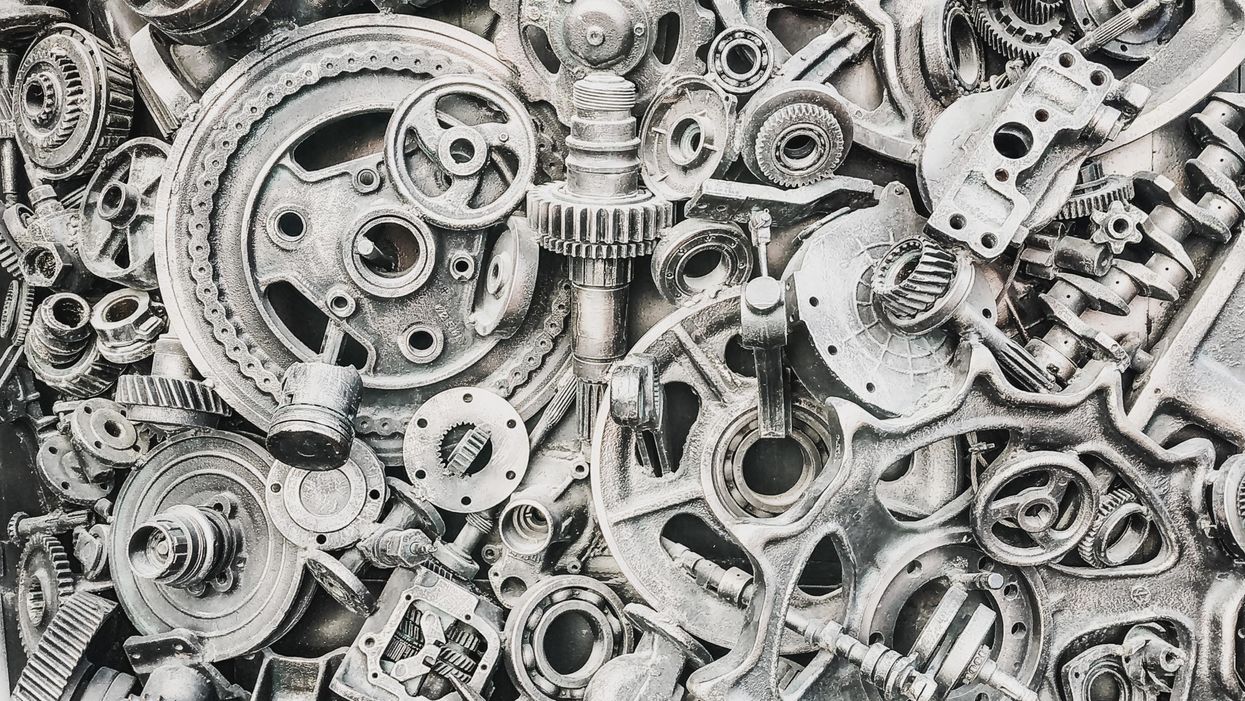How Can We Decide If a Biomedical Advance Is Ethical?
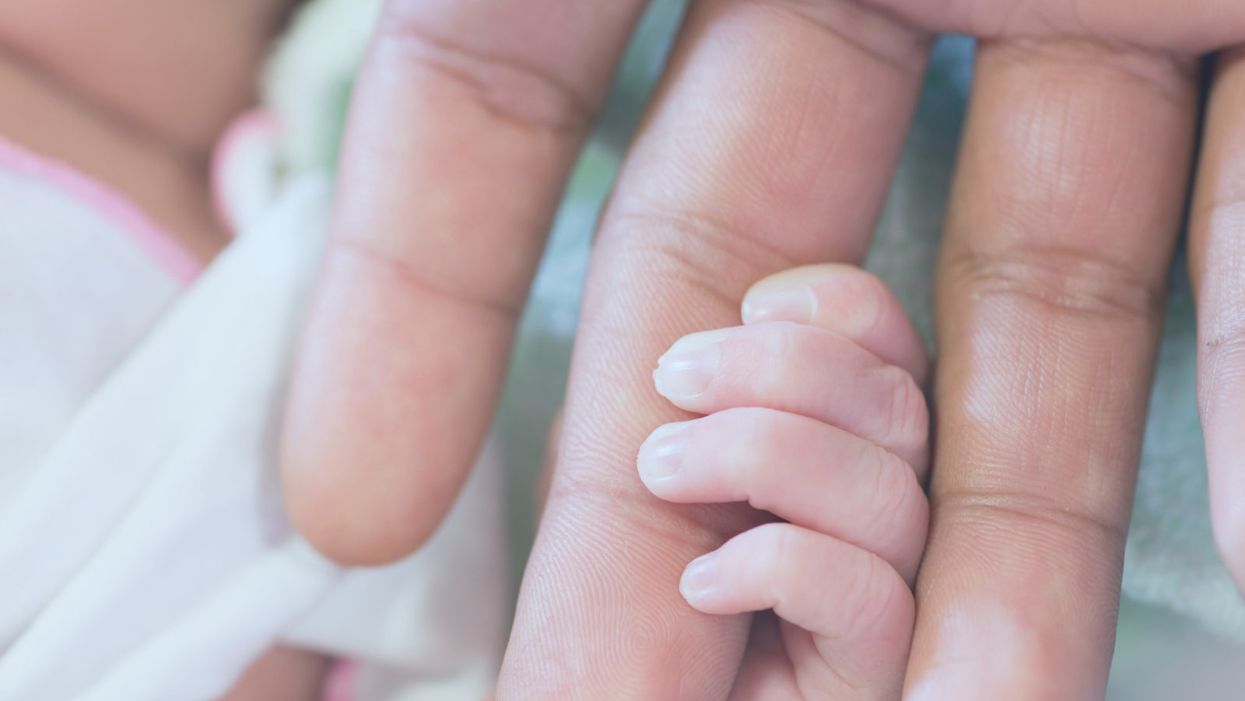
A newborn in the maternity ward. (© rufous/Fotolia)
"All fixed, fast-frozen relations, with their train of ancient and venerable prejudices and opinions, are swept away, all new-formed ones become antiquated before they can ossify. All that is solid melts into air, all that is holy is profaned…"
On July 25, 1978, Louise Brown was born in Oldham, England, the first human born through in vitro fertilization, through the work of Patrick Steptoe, a gynecologist, and Robert Edwards, a physiologist. Her birth was greeted with strong (though not universal) expressions of ethical dismay. Yet in 2016, the latest year for which we have data, nearly two percent of the babies born in the United States – and around the same percentage throughout the developed world – were the result of IVF. Few, if any, think of these children as unnatural, monsters, or freaks or of their parents as anything other than fortunate.
How should we view Dr. He today, knowing that the world's eventual verdict on the ethics of biomedical technologies often changes?
On November 25, 2018, news broke that Chinese scientist, Dr. He Jiankui, claimed to have edited the genomes of embryos, two of whom had recently become the new babies, Lulu and Nana. The response was immediate and overwhelmingly negative.
Times change. So do views. How will Dr. He be viewed in 40 years? And, more importantly, how should we view him today, knowing that the world's eventual verdict on the ethics of biomedical technologies often changes? And when what biomedicine can do changes with vertiginous frequency?
How to determine what is and isn't ethical is above my pay grade. I'm a simple law professor – I can't claim any deeper insight into how to live a moral life than the millennia of religious leaders, philosophers, ethicists, and ordinary people trying to do the right thing. But I can point out some ways to think about these questions that may be helpful.
First, consider two different kinds of ethical commands. Some are quite specific – "thou shalt not kill," for example. Others are more general – two of them are "do unto others as you would have done to you" or "seek the greatest good for the greatest number."
Biomedicine in the last two centuries has often surprised us with new possibilities, situations that cultures, religions, and bodies of ethical thought had not previously had to consider, from vaccination to anesthesia for women in labor to genome editing. Sometimes these possibilities will violate important and deeply accepted precepts for a group or a person. The rise of blood transfusions around World War I created new problems for Jehovah's Witnesses, who believe that the Bible prohibits ingesting blood. The 20th century developments of artificial insemination and IVF both ran afoul of Catholic doctrine prohibiting methods other than "traditional" marital intercourse for conceiving children. If you subscribe to an ethical or moral code that contains prohibitions that modern biomedicine violates, the issue for you is stark – adhere to those beliefs or renounce them.
If the harms seem to outweigh the benefits, it's easy to conclude "this is worrisome."
But many biomedical changes violate no clear moral teachings. Is it ethical or not to edit the DNA of embryos? Not surprisingly, the sacred texts of various religions – few of which were created after, at the latest, the early 19th century, say nothing specific about this. There may be hints, precedents, leanings that could argue one way or another, but no "commandments." In that case, I recommend, at least as a starting point, asking "what are the likely consequences of these actions?"
Will people be, on balance, harmed or helped by them? "Consequentialist" approaches, of various types, are a vast branch of ethical theories. Personally I find a completely consequentialist approach unacceptable – I could not accept, for example, torturing an innocent child even in order to save many lives. But, in the absence of a clear rule, looking at the consequences is a great place to start. If the harms seem to outweigh the benefits, it's easy to conclude "this is worrisome."
Let's use that starting place to look at a few bioethical issues. IVF, for example, once proven (relatively) safe seems to harm no one and to help many, notably the more than 8 million children worldwide born through IVF since 1978 – and their 16 million parents. On the other hand, giving unknowing, and unconsenting, intellectually disabled children hepatitis A harmed them, for an uncertain gain for science. And freezing the heads of the dead seems unlikely to harm anyone alive (except financially) but it also seems almost certain not to benefit anyone. (Those frozen dead heads are not coming back to life.)
Now let's look at two different kinds of biomedical advances. Some are controversial just because they are new; others are controversial because they cut close to the bone – whether or not they violate pre-established ethical or moral norms, they clearly relate to them.
Consider anesthesia during childbirth. When first used, it was controversial. After all, said critics, in Genesis, the Bible says God told Eve, "I will greatly multiply Your pain in childbirth, In pain you will bring forth children." But it did not clearly prohibit pain relief and from the advent of ether on, anesthesia has been common, though not universal, in childbirth in western societies. The pre-existing ethical precepts were not clear and the consequences weighed heavily in favor of anesthesia. Similarly, vaccination seems to violate no deep moral principle. It was, and for some people, still is just strange, and unnatural. The same was true of IVF initially. Opposition to all of these has faded with time and familiarity. It has not disappeared – some people continue to find moral or philosophical problems with "unnatural" childbirth, vaccination, and IVF – but far fewer.
On the other hand, human embryonic stem cell research touches deeper issues. Human embryos are destroyed to make those stem cells. Reasonable people disagree on the moral status of the human embryo, and the moral weight of its destruction, but it does at least bring into play clear and broadly accepted moral precepts, such as "Thou shalt not kill." So, at the far side of an individual's time, does euthanasia. More exposure to, and familiarity with, these practices will not necessarily lead to broad acceptance as the objections involve more than novelty.
The first is "what would I do?" The second – what should my government, culture, religion allow or forbid?
Finally, all this ethical analysis must work at two levels. The first is "what would I do?" The second – what should my government, culture, religion allow or forbid? There are many things I would not do that I don't think should be banned – because I think other people may reasonably have different views from mine. I would not get cosmetic surgery, but I would not ban it – and will try not to think ill of those who choose it
So, how should we assess the ethics of new biomedical procedures when we know that society's views may change? More specifically, what should we think of He Jiankui's experiment with human babies?
First, look to see whether the procedure in question violates, at least fairly clearly, some rule in your ethical or moral code. If so, your choice may not be difficult. But if the procedure is unmentioned in your moral code, probably because it was inconceivable to the code's creators, examine the consequences of the act.
If the procedure is just novel, and not something that touches on important moral concerns, looking at the likely consequences may be enough for your ethical analysis –though it is always worth remembering that predicting consequences perfectly is impossible and predicting them well is never certain. If it does touch on morally significant issues, you need to think those issues through. The consequences may be important to your conclusions but they may not be determinative.
And, then, if you conclude that it is not ethical from your perspective, you need to take yet another step and consider whether it should be banned for people who do not share your perspective. Sometimes the answer will be yes – that psychopaths may not view murder as immoral does not mean we have to let them kill – but sometimes it will be no.
What does this say about He Jiankui's experiment? I have no qualms in condemning it, unequivocally. The potential risks to the babies grossly outweighed any benefits to them, and to science. And his secret work, against a near universal scientific consensus, privileged his own ethical conclusions without giving anyone else a vote, or even a voice.
But if, in ten or twenty years, genome editing of human embryos is shown to be safe (enough) and it is proposed to be used for good reasons – say, to relieve human suffering that could not be treated in other good ways – and with good consents from those directly involved as well as from the relevant society and government – my answer might well change. Yours may not. Bioethics is a process for approaching questions; it is not a set of universal answers.
This article opened with a quotation from the 1848 Communist Manifesto, referring to the dizzying pace of change from industrialization and modernity. You don't need to be a Marxist to appreciate that sentiment. Change – especially in the biosciences – keeps accelerating. How should we assess the ethics of new biotechnologies? The best we can, with what we know, at the time we inhabit. And, in the face of vast uncertainty, with humility.
Scientists are making machines, wearable and implantable, to act as kidneys
Recent advancements in engineering mean that the first preclinical trials for an artificial kidney could happen soon.
Like all those whose kidneys have failed, Scott Burton’s life revolves around dialysis. For nearly two decades, Burton has been hooked up (or, since 2020, has hooked himself up at home) to a dialysis machine that performs the job his kidneys normally would. The process is arduous, time-consuming, and expensive. Except for a brief window before his body rejected a kidney transplant, Burton has depended on machines to take the place of his kidneys since he was 12-years-old. His whole life, the 39-year-old says, revolves around dialysis.
“Whenever I try to plan anything, I also have to plan my dialysis,” says Burton says, who works as a freelance videographer and editor. “It’s a full-time job in itself.”
Many of those on dialysis are in line for a kidney transplant that would allow them to trade thrice-weekly dialysis and strict dietary limits for a lifetime of immunosuppressants. Burton’s previous transplant means that his body will likely reject another donated kidney unless it matches perfectly—something he’s not counting on. It’s why he’s enthusiastic about the development of artificial kidneys, small wearable or implantable devices that would do the job of a healthy kidney while giving users like Burton more flexibility for traveling, working, and more.
Still, the devices aren’t ready for testing in humans—yet. But recent advancements in engineering mean that the first preclinical trials for an artificial kidney could happen soon, according to Jonathan Himmelfarb, a nephrologist at the University of Washington.
“It would liberate people with kidney failure,” Himmelfarb says.
An engineering marvel
Compared to the heart or the brain, the kidney doesn’t get as much respect from the medical profession, but its job is far more complex. “It does hundreds of different things,” says UCLA’s Ira Kurtz.
Kurtz would know. He’s worked as a nephrologist for 37 years, devoting his career to helping those with kidney disease. While his colleagues in cardiology and endocrinology have seen major advances in the development of artificial hearts and insulin pumps, little has changed for patients on hemodialysis. The machines remain bulky and require large volumes of a liquid called dialysate to remove toxins from a patient’s blood, along with gallons of purified water. A kidney transplant is the next best thing to someone’s own, functioning organ, but with over 600,000 Americans on dialysis and only about 100,000 kidney transplants each year, most of those in kidney failure are stuck on dialysis.
Part of the lack of progress in artificial kidney design is the sheer complexity of the kidney’s job. Each of the 45 different cell types in the kidney do something different.
Part of the lack of progress in artificial kidney design is the sheer complexity of the kidney’s job. To build an artificial heart, Kurtz says, you basically need to engineer a pump. An artificial pancreas needs to balance blood sugar levels with insulin secretion. While neither of these tasks is simple, they are fairly straightforward. The kidney, on the other hand, does more than get rid of waste products like urea and other toxins. Each of the 45 different cell types in the kidney do something different, helping to regulate electrolytes like sodium, potassium, and phosphorous; maintaining blood pressure and water balance; guiding the body’s hormonal and inflammatory responses; and aiding in the formation of red blood cells.
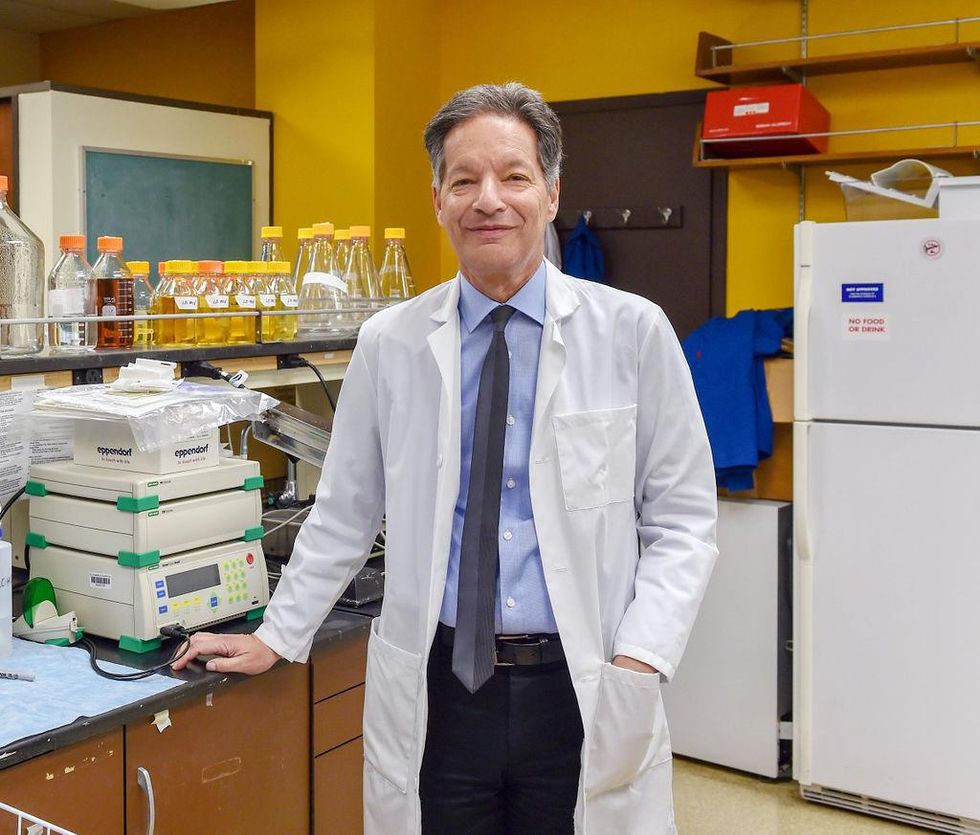
There's been little progress for patients during Ira Kurtz's 37 years as a nephrologist. Artificial kidneys would change that.
UCLA
Dialysis primarily filters waste, and does so well enough to keep someone alive, but it isn’t a true artificial kidney because it doesn’t perform the kidney’s other jobs, according to Kurtz, such as sensing levels of toxins, wastes, and electrolytes in the blood. Due to the size and water requirements of existing dialysis machines, the equipment isn’t portable. Physicians write a prescription for a certain duration of dialysis and assess how well it’s working with semi-regular blood tests. The process of dialysis itself, however, is conducted blind. Doctors can’t tell how much dialysis a patient needs based on kidney values at the time of treatment, says Meera Harhay, a nephrologist at Drexel University in Philadelphia.
But it’s the impact of dialysis on their day-to-day lives that creates the most problems for patients. Only one-quarter of those on dialysis are able to remain employed (compared to 85% of similar-aged adults), and many report a low quality of life. Having more flexibility in life would make a major different to her patients, Harhay says.
“Almost half their week is taken up by the burden of their treatment. It really eats away at their freedom and their ability to do things that add value to their life,” she says.
Art imitates life
The challenge for artificial kidney designers was how to compress the kidney’s natural functions into a portable, wearable, or implantable device that wouldn’t need constant access to gallons of purified and sterilized water. The other universal challenge they faced was ensuring that any part of the artificial kidney that would come in contact with blood was kept germ-free to prevent infection.
As part of the 2021 KidneyX Prize, a partnership between the U.S. Department of Health and Human Services and the American Society of Nephrology, inventors were challenged to create prototypes for artificial kidneys. Himmelfarb’s team at the University of Washington’s Center for Dialysis Innovation won the prize by focusing on miniaturizing existing technologies to create a portable dialysis machine. The backpack sized AKTIV device (Ambulatory Kidney to Increase Vitality) will recycle dialysate in a closed loop system that removes urea from blood and uses light-based chemical reactions to convert the urea to nitrogen and carbon dioxide, which allows the dialysate to be recirculated.
Himmelfarb says that the AKTIV can be used when at home, work, or traveling, which will give users more flexibility and freedom. “If you had a 30-pound device that you could put in the overhead bins when traveling, you could go visit your grandkids,” he says.
Kurtz’s team at UCLA partnered with the U.S. Kidney Research Corporation and Arkansas University to develop a dialysate-free desktop device (about the size of a small printer) as the first phase of a progression that will he hopes will lead to something small and implantable. Part of the reason for the artificial kidney’s size, Kurtz says, is the number of functions his team are cramming into it. Not only will it filter urea from blood, but it will also use electricity to help regulate electrolyte levels in a process called electrodeionization. Kurtz emphasizes that these additional functions are what makes his design a true artificial kidney instead of just a small dialysis machine.
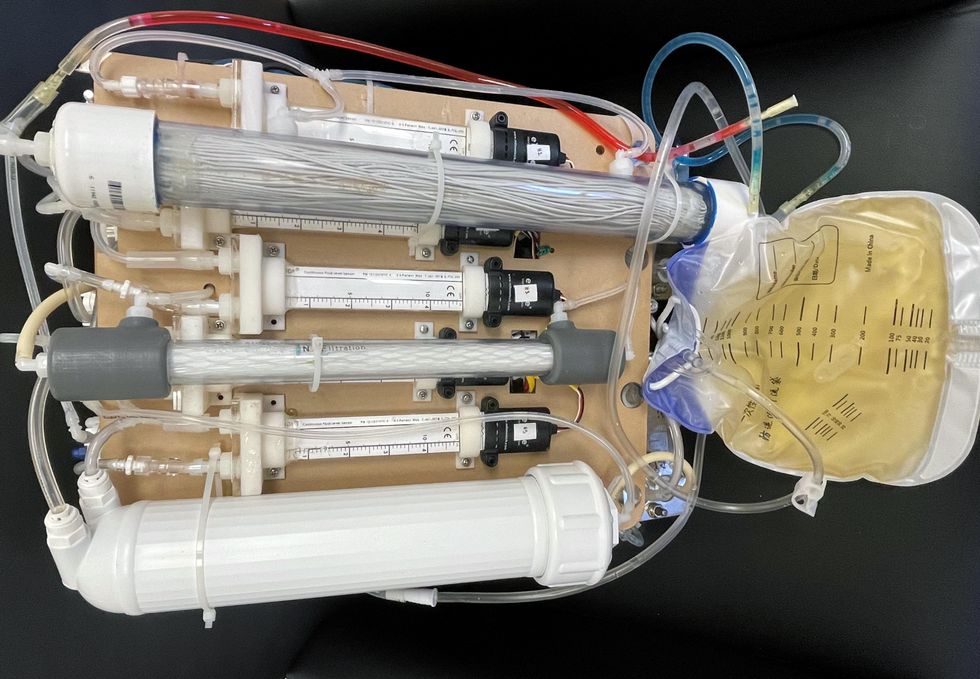
One version of an artificial kidney.
UCLA
“It doesn't have just a static function. It has a bank of sensors that measure chemicals in the blood and feeds that information back to the device,” Kurtz says.
Other startups are getting in on the game. Nephria Bio, a spinout from the South Korean-based EOFlow, is working to develop a wearable dialysis device, akin to an insulin pump, that uses miniature cartridges with nanomaterial filters to clean blood (Harhay is a scientific advisor to Nephria). Ian Welsford, Nephria’s co-founder and CTO, says that the device’s design means that it can also be used to treat acute kidney injuries in resource-limited settings. These potentials have garnered interest and investment in artificial kidneys from the U.S. Department of Defense.
For his part, Burton is most interested in an implantable device, as that would give him the most freedom. Even having a regular outpatient procedure to change batteries or filters would be a minor inconvenience to him.
“Being plugged into a machine, that’s not mimicking life,” he says.
This article was first published by Leaps.org on May 5, 2022.
With this new technology, hospitals and pharmacies could make vaccines and medicines onsite
New research focuses on methods that could change medicine-making worldwide. The scientists propose bursting cells open, removing their DNA and using the cellular gears inside to make therapies.
Most modern biopharmaceutical medicines are produced by workhorse cells—typically bacterial but sometimes mammalian. The cells receive the synthesizing instructions on a snippet of a genetic code, which they incorporate into their DNA. The cellular machinery—ribosomes, RNAs, polymerases, and other compounds—read and use these instructions to build the medicinal molecules, which are harvested and administered to patients.
Although a staple of modern pharma, this process is complex and expensive. One must first insert the DNA instructions into the cells, which they may or may not uptake. One then must grow the cells, keeping them alive and well, so that they produce the required therapeutics, which then must be isolated and purified. To make this at scale requires massive bioreactors and big factories from where the drugs are distributed—and may take a while to arrive where they’re needed. “The pandemic showed us that this method is slow and cumbersome,” says Govind Rao, professor of biochemical engineering who directs the Center for Advanced Sensor Technology at the University of Maryland, Baltimore County (UMBC). “We need better methods that can work faster and can work locally where an outbreak is happening.”
Rao and his team of collaborators, which spans multiple research institutions, believe they have a better approach that may change medicine-making worldwide. They suggest forgoing the concept of using living cells as medicine-producers. Instead, they propose breaking the cells and using the remaining cellular gears for assembling the therapeutic compounds. Instead of inserting the DNA into living cells, the team burst them open, and removed their DNA altogether. Yet, the residual molecular machinery of ribosomes, polymerases and other cogwheels still functioned the way it would in a cell. “Now if you drop your DNA drug-making instructions into that soup, this machinery starts making what you need,” Rao explains. “And because you're no longer worrying about living cells, it becomes much simpler and more efficient.” The collaborators detail their cell-free protein synthesis or CFPS method in their recent paper published in preprint BioAxiv.
While CFPS does not use living cells, it still needs the basic building blocks to assemble proteins from—such as amino acids, nucleotides and certain types of enzymes. These are regularly added into this “soup” to keep the molecular factory chugging. “We just mix everything in as a batch and we let it integrate,” says James Robert Swartz, professor of chemical engineering and bioengineering at Stanford University and co-author of the paper. “And we make sure that we provide enough oxygen.” Rao likens the process to making milk from milk powder.
For a variety of reasons—from the field’s general inertia to regulatory approval hurdles—the method hasn’t become mainstream. The pandemic rekindled interest in medicines that can be made quickly and easily, so it drew more attention to the technology.
The idea of a cell-free protein synthesis is older than one might think. Swartz first experimented with it around 1997, when he was a chemical engineer at Genentech. While working on engineering bacteria to make pharmaceuticals, he discovered that there was a limit to what E. coli cells, the workhorse darling of pharma, could do. For example, it couldn’t grow and properly fold some complex proteins. “We tried many genetic engineering approaches, many fermentation, development, and environmental control approaches,” Swartz recalls—to no avail.
“The organism had its own agenda,” he quips. “And because everything was happening within the organism, we just couldn't really change those conditions very easily. Some of them we couldn’t change at all—we didn’t have control.”
It was out of frustration with the defiant bacteria that a new idea took hold. Could the cells be opened instead, so that the protein-forming reactions could be influenced more easily? “Obviously, we’d lose the ability for them to reproduce,” Swartz says. But that also meant that they no longer needed to keep the cells alive and could focus on making the specific reactions happen. “We could take the catalysts, the enzymes, and the more complex catalysts and activate them, make them work together, much as they would in a living cell, but the way we wanted.”
In 1998, Swartz joined Stanford, and began perfecting the biochemistry of the cell-free method, identifying the reactions he wanted to foster and stopping those he didn’t want. He managed to make the idea work, but for a variety of reasons—from the field’s general inertia to regulatory approval hurdles—the method hasn’t become mainstream. The pandemic rekindled interest in medicines that can be made quickly and easily, so it drew more attention to the technology. For their BioArxiv paper, the team tested the method by growing a specific antiviral protein called griffithsin.
First identified by Barry O’Keefe at National Cancer Institute over a decade ago, griffithsin is an antiviral known to interfere with many viruses’ ability to enter cells—including HIV, SARS, SARS-CoV-2, MERS and others. Originally isolated from the red algae Griffithsia, it works differently from antibodies and antibody cocktails.
Most antiviral medicines tend to target the specific receptors that viruses use to gain entry to the cells they infect. For example, SARS-CoV-2 uses the infamous spike protein to latch onto the ACE2 receptor of mammalian cells. The antibodies or other antiviral molecules stick to the spike protein, shutting off its ability to cling onto the ACE2 receptors. Unfortunately, the spike proteins mutate very often, so the medicines lose their potency. On the contrary, griffithsin has the ability to cling to the different parts of viral shells called capsids—namely to the molecules of mannose, a type of sugar. That extra stuff, glued all around the capsid like dead weight, makes it impossible for the virus to squeeze into the cell.
“Every time we have a vaccine or an antibody against a specific SARS-CoV-2 strain, that strain then mutates and so you lose efficacy,” Rao explains. “But griffithsin molecules glom onto the viral capsid, so the capsid essentially becomes a sticky mess and can’t enter the cell.” Mannose molecules also don’t mutate as easily as viruses’ receptors, so griffithsin-based antivirals do not have to be constantly updated. And because mannose molecules are found on many viruses’ capsids, it makes griffithsin “a universal neutralizer,” Rao explains.
“When griffithsin was discovered, we recognized that it held a lot of promise as a potential antiviral agent,” O’Keefe says. In 2010, he published a paper about griffithsin efficacy in neutralizing viruses of the corona family—after the first SARS outbreak in the early 2000s, the scientific community was interested in such antivirals. Yet, griffithsin is still not available as an off-the-shelf product. So during the Covid pandemic, the team experimented with synthesizing griffithsin using the cell-free production method. They were able to generate potent griffithsin in less than 24 hours without having to grow living cells.
The antiviral protein isn't the only type of medicine that can be made cell-free. The proteins needed for vaccine production could also be made the same way. “Such portable, on-demand drug manufacturing platforms can produce antiviral proteins within hours, making them ideal for combating future pandemics,” Rao says. “We would be able to stop the pandemic before it spreads.”
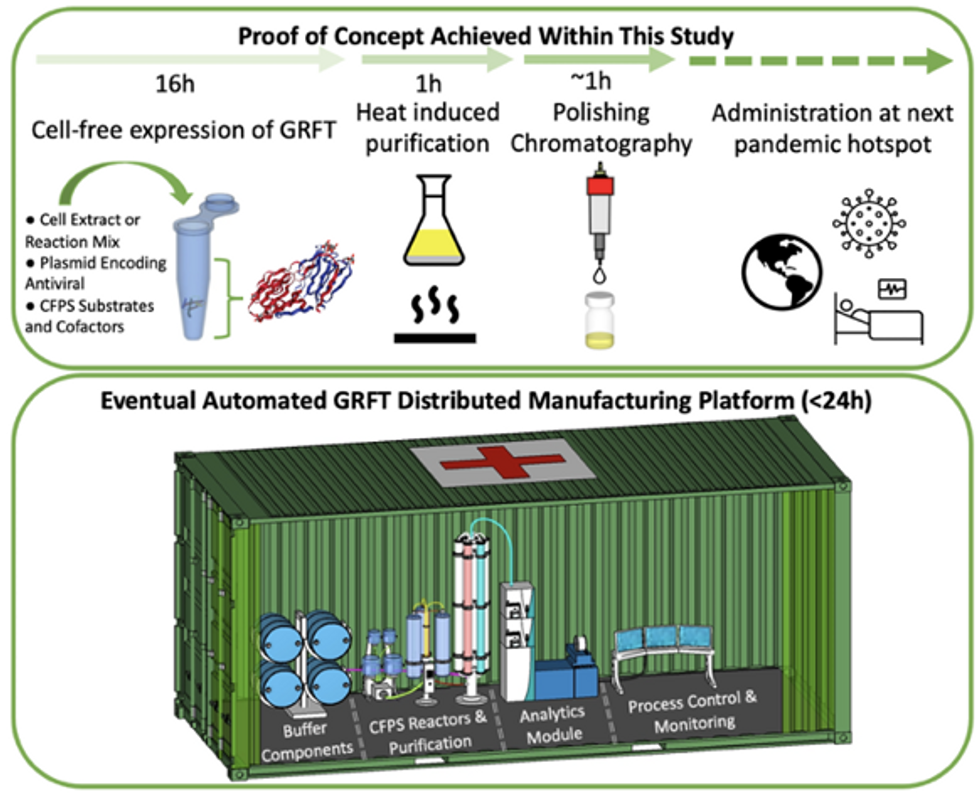
Top: Describes the process used in the study. Bottom: Describes how the new medicines and vaccines could be made at the site of a future viral outbreak.
Image courtesy of Rao and team, sourced from An approach to rapid distributed manufacturing of broad spectrumanti-viral griffithsin using cell-free systems to mitigate pandemics.
Rao’s idea is to perfect the technology to the point that any hospital or pharmacy can load up the media containing molecular factories, mix up the required amino acids, nucleotides and enzymes, and harvest the meds within hours. That will allow making medicines onsite and on demand. “That would be a self-contained production unit, so that you could just ship the production wherever the pandemic is breaking out,” says Swartz.
These units and the meds they produce, will, of course, have to undergo rigorous testing. “The biggest hurdles will be validating these against conventional technology,” Rao says. The biotech industry is risk-averse and prefers the familiar methods. But if this approach works, it may go beyond emergency situations and revolutionize the medicine-making paradigm even outside hospitals and pharmacies. Rao hopes that someday the method might become so mainstream that people may be able to buy and operate such reactors at home. “You can imagine a diabetic patient making insulin that way, or some other drugs,” Rao says. It would work not unlike making baby formula from the mere white powder. Just add water—and some oxygen, too.
Lina Zeldovich has written about science, medicine and technology for Popular Science, Smithsonian, National Geographic, Scientific American, Reader’s Digest, the New York Times and other major national and international publications. A Columbia J-School alumna, she has won several awards for her stories, including the ASJA Crisis Coverage Award for Covid reporting, and has been a contributing editor at Nautilus Magazine. In 2021, Zeldovich released her first book, The Other Dark Matter, published by the University of Chicago Press, about the science and business of turning waste into wealth and health. You can find her on http://linazeldovich.com/ and @linazeldovich.
